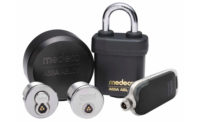Technology around the door has never been simpler — or more complicated — depending on your perspective. The time-honored method of locksmiths covering the door and hardware aspect and integrators doing the back-end electronic components no longer applies with the advent of the integrated lock and other electronic or electrified lock components. Wireless technology, Power over Ethernet (PoE), smart IP and edge devices, and Wi-Fi locks are a game changer for everyone.
“One of the top advancements in recent years is the wireless lock technology that allows flexibility in installations,” says Bill Smoyer, national sales manager, Access Hardware Supply, San Leandro, Calif. “It has opened up new areas for access control, including muster readers, remote pedestrian and vehicle gates, locker and cabinet, and server rack locks. PoE lock hardware has also enabled the integrator to use existing wiring infrastructure, which saves labor.”
These technologies represent a huge opportunity for integrators. “As locks become more sophisticated, there is a big chance for the integrator to get in there and work if they want to,” says Brian Moses, Eastern regional distribution manager, KABA Access & Data Systems-Americas, Winston Salem, N.C. “As a manufacturer, if we want to be successful we have to look toward the integrator to do more of the installation because it is very important that the customer has after-sales support.”
Increasingly, that means integrators are taking on more of the at-the-door installation or sales, says Scott Lowder, product manager for electronic access control, ASSA ABLOY Americas, New Haven, Conn. “As we move towards the more complex needs of our customers and they want more monitoring and intelligence on the doors, integrators are playing a bigger role in how it gets on the door and gets connected. Increasingly it is the integrator proposing the door solution and making those final connections. The mechanical portion is a smaller and smaller piece.”
What this means is a huge shift in the technical skill set, which is something both integrators and locksmiths are struggling to catch up with, adds Robert Lovato, tech support manager, Security Door Controls (SDC), Camarillo, Calif. “I see an industry where the technical ability has probably never been so low. There are not a lot of master craftsmen for this. Locksmiths are looking at electronics and integrators at hardware. The new player is the IT personnel because things are IP initiated. Three parties are all running towards an industry and no one really has it down yet.”
There is quite a bit of confusion, adds John Hunepohl, director of education, ASSA ABLOY Americas. “Locks are specified under Division 08 and electronic access control is specified under Division 28 in the Construction Specification Institute MasterFormat. When it is built into the lock, where do you put it and who owns it? It is still a lock, but it also has to function as access control. There is this trend for manufacturers to offer solutions that cross boundaries. The challenge is who does what and at what stage. Who owns the door?”
Increasingly the answer is the integrator, whether they like it or not. “It doesn’t matter if it was installed by a locksmith,” Hunepohl adds. “Once the system goes in and something goes wrong the integrator is the one they will call.”
Making Installations ‘Simpler’
To help integrators and locksmiths alike, manufacturers are designing products that require less time, fewer wires and more integrated components.
“Our locks today act as a single door controller and/or an intelligent edge device with its own power, built-in ID reader, door position switch — and installs in under an hour,” says Judith Jones-Shand, vice president, marketing, Napco Security Technologies Inc., Amityville, N.Y.
“For us, the simpler we can make it the more sales we are going to have,” Moses says. “We have a product coming out that will fit into an existing prep. You have to make it easy now. If you don’t, not even the locksmiths will install it. Ease of installation is a big deal for everyone.”
Karen Keating, portfolio manager for electronics, Allegion, Carmel, Ind., agrees. “From an installation perspective, our ENGAGE technology gives the ability to put a wireless lock on a door and install it in less than 15 minutes with just a screwdriver. Simplifying it and making it more attractive for an integrator to want to install it on the door was one of our main goals.”
But with all of these new advancements making things easier and faster, there is a flip side on the installation end, and in some cases unintended consequences that can add hiccups to the job.
“I see a lot of products going to where they are trying to make it less work for the installer, but sometimes that leads to a higher failure rate,” says Julie Collins, vice president, ROFU International Corp., Lakewood, Wash. She offers an example: “Regretfully, in the U.S. our doors aren’t always square. If the door is not hung square and then you use strikes that require less cutting in the jamb but more precise installation, things aren’t going to always work right.”
Perhaps the biggest confusion point in installation today is a byproduct of the converging of technologies: Whose job is it to do what?
“The more we simplify things, the more it can cross the lines in terms of who physically installs it on a door,” Keating says.
“Convergence is a buzzword that is occurring on several levels,” Lovato adds. “Industries are converging, but so are tradespeople.”
In general, both integrators and locksmiths need to get comfortable with the door and the electronics surrounding it, because the way things have always been done is changing rapidly.
“When we came up with an integrated product, we took all those components from around the door and put them into the lock,” Hunepohl says. “We, as manufacturers, said, ‘this is a better solution,’ but the integrator says ‘what you have done is take them and put them into this component that goes on the door, which I am already nervous about.’ We have had to educate integrators and architects and locksmiths and show them that this way is truly better.”
A Matter of Training
For both the integrator, who doesn’t understand the door hardware, and the locksmith, who doesn’t know the electronics beyond the door, getting training is the first, best thing they can do to reduce the fear factor.
“Ultimately the training of integrators falls in great part to the manufacturer, because a well-trained, well-versed security professional representing and deploying your product is the best investment a security manufacturer can make,” Jones-Shand says. “Alarm Lock is just debuting a training portal on its website where integrators, dealers and locksmiths can take part in training or view pre-recorded sessions.”
Some manufacturers go so far as to require training on certain products before allowing dealers and integrators to sell and install them.
“Integrators come from a very diverse background,” Lowder says. “Some are very comfortable with an IP environment. Others lack experience in that area. For this type of product, in order for you to have access to it, we require a certain level of training. The worst case for us is to have our product selected, then have the integrator or end user have a negative experience with it.”
The popularity of classes for integrators and locksmiths alike is evidence that training is working. “Every time we have any kind of those classes they sell out within 24 to 48 hours and are split evenly between locksmiths and integrators,” Hunepohl describes.
“Over the past 18 months we have made a focused effort in the integrator community and had a class specific to wireless lock installation,” Keating says. “Our philosophy is to arm them with information, train them, and equip them to do their job.”
Lowder groups integrators in to two types. “Group A still prefers traditional access. If you twist their arm and they are required to provide an integrated solution, they will do it but with resistance. Group B are those who have tried the newer technologies and surprised by the success. Our goal is to educate the first group of integrators before they are forced to do it on a job and have a bad experience. If they can start with a small project and learn in a controlled environment before going on site, they are far more likely to have a positive experience and become part of Group B, who can no longer see doing it any other way.”
Hunepohl agrees. “It is much faster and more profitable to install integrated IP locks than to install several discreet components around the door. You can pull one cable instead of four. In theory that sounds good, but suddenly they have to pull it down the frame and through the door. They have to core the door. If they only do it rarely it is not going to be faster than the four components because they have a system for that. It is only true once they do a few of them. Education is an important part of that.”
This goes for locksmiths as well, Lovato says. “Locksmiths don’t know what PoE means. They will glaze over if you use the term ‘initialize.’ We are trying to develop classes so locksmiths can understand what structured cabling is, how power comes into the building. We have to get locksmiths from the front door to the data room and we have to get the integrator to the door.”
SIDEBAR: Good Advice
When it comes to the unfamiliar, the best place to ask for advice is the provider of the technology. Manufacturers weigh in on their observations of common pitfalls and advice for integrators.
Don’t get stuck on one solution or product.
“Sometimes integrators get stuck on one product line and get focused on that to the exclusion of other options or other manufacturers that might offer them an alternate or better solution,” says Julie Collins at ROFU International Corp.
“Different types of customers have different needs and that is why we have a diversity of solutions,” adds Scott Lowder, ASSA ABLOY Americas. “But we find again and again that integrators have something they are familiar with and comfortable installing, and they tend to try to apply it to every situation.”
Get involved early and know who will do what.
“We had a customer put our integrated wireless products into a hospital,” recalls John Hunepohl, ASSA ABLOY Americas. “At a meeting with the installer, integrator, facility owner and lock supplier, we asked, ‘Who will be installing the lock?’ It was actually the same person that does the sheetrock. Because of union requirements, there was an issue of who could plug in the cables. The integrator literally had to stand over the guy’s shoulder to plug them in.”
Unfortunately, these scenarios happen all too often because of local codes, unions or confusion over whose job it is, adds Robert Lovato of Security Door Controls (SDC). “Unions will throw electricians into the mix and they don’t know low-voltage relay technology. The most qualified guy should be doing the whole thing, but that isn’t always the case.”
Start small and get educated.
“The best case scenario is to try an integrated or IP-based product on a small test site and see the benefits,” Lowder says. “We are confident that once an integrator tries one of these very different solutions they will embrace it and wonder why they were still doing it the traditional way up to that point.”
Hunepohl agrees. “If you become educated you take the fear away. People resist change naturally, but once they try this on a smaller scale they are ready to go to the larger stuff.”
Make detailed checklists and ask the right questions.
“Integrators should spend time on a door survey before the installer arrives at the job,” says Bill Smoyer of Access Hardware Supply.
One of the biggest problems Lovato sees is that the person specifying the job doesn’t understand the door. “They overlook certain details, which creates hardships for the installers and can cause them to lose profits because of an inability to finish the job without adding components.
“They need to have a detailed door checklist that addresses all facets of the opening, including the handing of doors, hinging, pivoting, door size, width, height, thickness, and more. How thick are the bolts? What are the lock heights? Does the door closer have a hold open feature? These are things that could pose serious problems if installers miss them,” he relates.






